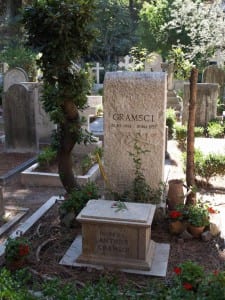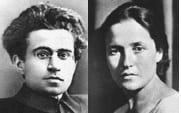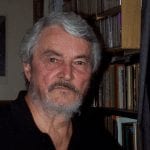Antonio Gramsci – Italian Professional Revolutionary
//
=By= Gaither Stewart

“Telling the truth is always revolutionary.”
[dropcap]T[/dropcap]oday I visited the tomb of Antonio Gramsci in the Poets’ Cemetery in Rome, a final resting place for artists, poets, writers and illustrious foreigners and lovers of Italy. January 22 is the birthday of the Italian professional revolutionary and founder of the Italian Communist Party in 1921. An inconspicuous urn resting in the center of the mound contains the ashes of the philosopher and Marxist thinker. The tombstone bears only his name and his dates—1891-1937. Fresh red flowers indicate that the site is regularly tended.
I visited the tomb of Gramsci also because I wanted to speak of the man who in my mind is most representative of the better side of tormented twentieth century Italy, an advocate of a new social-political-economic structure and a major figure in shaping progressive thought from the early XX century.
I wanted to speak of Gramsci because the Italy that many people love continues to be threatened by a contagious right-wing populism. Since the demise of the Italian Communist Party in 1991 and in the wake of successive right, center-right and center governments often led by populists, Italy has experienced depths of reaction and wishy-washy governments that would cause Gramsci’s progressive spirit to wing its way to other worlds.
The figure of Antonio Gramsci is emblematic of the profound dichotomy between progress and reaction that has marked much of Europe since the end of the nineteenth century. The Marxist Gramsci would have ambivalent feelings about his neighbors in the Poets’ Cemetery: lying near him are dozens of “White Russian exiles,” whose culture was dedicated to maintaining the hegemony of the Russian upper class over the masses, which Gramsci opposed. They were the adversaries of the Bolshevik revolution in Tsarist Russia in 1917, which Gramsci supported.
On the other hand, Gramsci must have had sympathy for the progressive English poets, John Keats and Percy Byshe Shelley, who lie under two pines in a distant corner of the same cemetery. Keats (“I saw pale kings, and princes too” from his La Belle Dame san merci) wrote, as Gramsci must have at some point, “I am ambitious to do the world some good.”

Antonio Gramsci, 30 years old, and his Russian wife, Julia Schucht. Gramsci went to Moscow in May 1922 and became a member of the Comintern Executive Committee. He lived in Moscow until November, 1923. During that time he met and married Julia Schucht, a member of the Bolshevik Party, the daughter of a friend of Lenin, Apollon Schucht. Julia was rumored to be an agent of Lenin’s secret services, the OGPU under Feliks Dzerzinsky. So Gramsci’s meeting with her was either a romantic love at first sight or Julia was controlled by Lenin. I set my novel, Time of Exile, at the Poets’ Cemetery and in a house on the short, cobblestone street, Via Trapani in the Nomentano district of Rome, where Julia and some of the Trapani family lived while Gramsci was in prison. Julia returned to the Soviet Union after Gramsci’s death, while some of the family remained in Italy. See Julia Schucht on the web for many curiosities of the era.
Keats arrived in Rome a sick man—as Gramsci was all his life—and died at age twenty-six after choosing the Poets’ Cemetery for his resting place. Shelley, who preferred “painful pleasures to easier ones”, also lived his last years in Italy where he died in a Mediterranean storm near Lerici and joined his friend Keats a year later.
As much as he appreciated their culture and admired Keats’ universal words, ‘Beauty is truth, truth beauty,’ Antonio Gramsci, did not worship all the names of the Western literary canon because, he believed, there was usually an unacceptable ideology involved in their canonization. In his Selections from the Prison Notebooks he writes of the difficulty of intellectuals to be free of the dominant social group (the major problem of western intellectuals today and especially in the USA!); he was mistrustful of the esprit de corps and the compromises running through the Italian and European intellectual community of his times.
While poetry, for example, in the Anglophone world has often remained distant from the political world in the popular belief that “poetry does not count”, in the world at large poets have often led the charge against colonialism, imperialism and fascism: like Martì in Cuba, Ernesto Cardenal in Nicaragua, Federico Garcìa Lorca in Spain, Paul Eluard in France, Quasimodo in Italy, Pablo Neruda in Chile.
Poetry can and does fuel free-thinking and democratic strivings. The poet is an intellectual in Italian revolutionary Antonio Gramsci’s sense: “Non-intellectuals do not exist,” he writes, because “there is no human activity from which every form of intellectual participation can be excluded: homo faber cannot be separated from homo sapiens.” Gramsci suggests that activism, not only eloquence, is a determining principle of the intellectual’s function “as constructor, organizer, permanent persuader, and not just a simple orator.”
Born in Sardinia, Gramsci moved to Turin in 1913. At the university there he came into contact with the strong Socialist movement. He was then a co-founder of the Italian Communist Party in 1921 and became its head the year after. He was elected to Parliament in 1923. Three years later he was arrested by the Fascist police and spent most of the rest of his life in prison.
Like most great men Gramsci hoped to change the world. His point of departure was the Marxist idea that everything in life is determined by capital. The class that controls capital is the dominant class. The capitalist class formulates its ideology to secure its control—or in Gramscian language, its hegemony—over the people. Class struggle results when the people try to change the rules and take power.
The task of intellectuals is to lead and act politically in order to change the world. “Let men be judged by what they do, not what they say.”
The Marxist Gramsci knew nothing of Lenin until 1917 and Lenin probably only learned of Gramsci when he founded the Italian Communist Party and while he was in Moscow. In any case, Leninism was only one ingredient in Gramsci’s theory for social change. While Leninism is now largely history, many of Gramsci’s contributions to Socialist thought are intact: the intellectual pursuit and culture.
Though Gramsci was interested in political action and believed in the necessity of a political movement, in his thinking revolutionary violence is not the only path to challenge the hegemony of the capitalist class. Though a revolutionary, not a pacifist, he did not advocate a Leninist totalitarian world outlook.
Gramsci amended Marx’s conviction that social development originates only from the economic structure. His distinction of culture was a major advance for radical thought, and it still holds today. His point was and is: although culture does not lead social change, it is just a step behind.
The Italian Marxist recognized that political freedom is a requisite for culture; if religious or political fanaticism suppresses the society, art will not flower. To write propaganda or paint conformist art is to succumb to the allures and/or the coercion of the reigning system. For that reason most artists, like Keats and Shelly, are countercurrent. That is also why artists should stay far away from the White House or the Elysées Palace.
Gramsci like other Marxists insisted on the role of intellectuals to lead the way toward reform. Gramsci believed that mass media, the instrument used by the dominant class to spread its hegemony, can also be used to counter that hegemony. Throughout the world today we see the confrontation—still unequal—between establishment media on the one side and the spread of alternative media on the other: independent publishers and filmmakers and the free “alternative” press.
 Senior Editor Gaither Stewart, based in Rome, serves—inter alia—as our European correspondent. A veteran journalist and essayist on a broad palette of topics from culture to history and politics, he is also the author of the Europe Trilogy, celebrated spy thrillers whose latest volume, Time of Exile, was just published by Punto Press.
Senior Editor Gaither Stewart, based in Rome, serves—inter alia—as our European correspondent. A veteran journalist and essayist on a broad palette of topics from culture to history and politics, he is also the author of the Europe Trilogy, celebrated spy thrillers whose latest volume, Time of Exile, was just published by Punto Press.
Lead Graphic: The grave of Antonio Gramsci in Rome.
Note to Commenters
Due to severe hacking attacks in the recent past that brought our site down for up to 11 days with considerable loss of circulation, we exercise extreme caution in the comments we publish, as the comment box has been one of the main arteries to inject malicious code. Because of that comments may not appear immediately, but rest assured that if you are a legitimate commenter your opinion will be published within 24 hours. If your comment fails to appear, and you wish to reach us directly, send us a mail at: editor@greanvillepost.com
We apologize for this inconvenience.
 Nauseated by the
Nauseated by the
vile corporate media?
Had enough of their lies, escapism,
omissions and relentless manipulation?
Send a donation to
The Greanville Post–or
But be sure to support YOUR media.
If you don’t, who will?